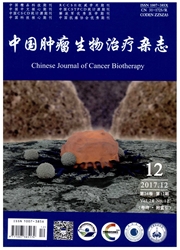

 中文摘要:
中文摘要:
目的:研究乳腺癌患者肿瘤组织中髓源抑制性细胞(myeloid-derived suppressor cells,MDSCs)与乳腺癌临床病理特征的关系。方法:收集天津肿瘤医院2009年2月至2009年12月间35例乳腺癌根治术的手术切除组织标本,制成单细胞悬液;流式细胞术检测其中MDSCs(Lin-CD33+CD13+CD14-CD15-)比例,免疫组化法检测同一肿瘤组织中ER、PR、Her-2表达;分析MDSCs比例与患者临床病理特征的关系。结果:乳腺癌患者肿瘤组织中MDSCs比例与临床分期、淋巴结转移有关,Ⅲ期患者MDSCs比例[(11.70±7.85)%]高于Ⅰ/Ⅱ期患者[(5.32±4.59)%],发生3个以上淋巴结转移患者的MDSCs比例[(10.97±7.87)%]高于3个以下(含3个)淋巴结转移的患者[(5.86±5.26)%](P〈0.05)。未观察到MDSCs比例高低与患者年龄、病理类型、肿瘤直径、组织学分级,以及ER、PR、Her-2表达有关(P〉0.05)。结论:乳腺癌患者肿瘤组织中MDSCs比例与患者临床分期、淋巴结转移有关,MDSCs增多可能是乳腺癌患者发生免疫抑制的重要原因之一。
 英文摘要:
英文摘要:
Objective:To examine the myeloid-derived suppressor cells(MDSCs) in breast cancer tissues and their relationship with clinicopathological characteristics of breast cancer.Methods: Thirty-five breast cancer samples were obtained from Tianjin Cancer Hospital(from Feb.2009 to Dec.2009),and single cell suspensions were prepared.The proportions of MDSCs(Lin-CD33+CD13+CD14-CD15-)in breast cancer tissues were determined by flow cytometry.Immunohistochemistry was used to detect the expressions of ER,PR,Her-2 proteins in the same tumor tissues.Then we analyzed the correlation of MDSCs ratio with clinical characteristics of breast cancer.Results: The MDSCs ratio in breast cancer tissues was correlated with the clinical stage and metastasis lymph node numbers in breast cancer patients,with the ratio in stage Ⅲ breast cancer patients([11.70±7.85]%) being significantly higher than that in stage Ⅰ/Ⅱ patients([5.32±4.59]%).Patients with more than 3 metastasis lymph nodes had a higher MDSCs ratio([10.97±7.87]%) than patients with less than 3 metastasis lymph nodes([5.86±5.26]%,P〈0.05).MDSCs ratio was not correlated with ages,pathologic types,tumor diameters,histological grades,or expressions of ER,PR and Her-2 of breast cancer patients(P〉0.05).Conclusion: The MDSCs ratio in breast cancer tissues is correlated with the clinical stage and lymph node metastasis of breast cancer,and the increased MDSCs numbers may be an important reason of immune suppression in breast cancer patients
 同期刊论文项目
同期刊论文项目
 同项目期刊论文
同项目期刊论文
 期刊信息
期刊信息
